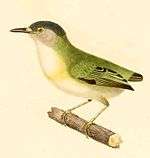Short-tailed pygmy tyrant
| Short-tailed pygmy tyrant | |
|---|---|
 | |
| Short-tailed pygmy tyrant at Apiacás, Mato Grosso state, Brazil | |
| Scientific classification | |
| Kingdom: | Animalia |
| Phylum: | Chordata |
| Class: | Aves |
| Order: | Passeriformes |
| Family: | Tyrannidae |
| Genus: | Myiornis |
| Species: | M. ecaudatus |
| Binomial name | |
| Myiornis ecaudatus (D'Orbigny and Lafresnaye, 1837) | |
The short-tailed pygmy tyrant (Myiornis ecaudatus) is not only the smallest member of the tyrant-flycatcher family, but also the smallest passerine on earth. Among both the family and the order, only the closely related black-capped pygmy tyrant approaches similarly diminutive sizes. The pygmy tyrant is widespread throughout most of the Amazon in northern and central South America.
A resident of tall humid forests, the bird is occasionally found in more open woodland, specifically around treefalls and tall trees in clearings. It is fairly common throughout most of its range, but is easily overlooked - in part due to its insect or frog-like voice.
The short-tailed pygmy tyrant is truly a pygmy of a bird, with only a handful of the most lilliputian hummingbirds measuring smaller. The average length is 6.5 cm (2.6 in) and the weight averages at 4.2 g (0.15 oz). While the bill (though slender) is disproportionately large for the size of the bird, the tail is practically non-existent. The head is gray with blackish lores and stand-out white "spectacles". The back is bright olive-green, and the bar-less wings and tail are both black. The underside is yellow-tinged white, with light olive smudges on the chest and flanks, and the inner flight feathers are edged with yellow. The sexes are similar. Although its plumage is similar to some other tyrant flycatchers, especially the slaty-headed tody-flycatcher, in the field, the bird is more often mistaken for a large beetle or insect, especially while in flight.
The nest, a moss and fiber ball with a side entrance, is large for the size of the bird. It may be found from 1 to 8 meters (3.3 to 26.2 ft) up in the tree, and never near the canopy. 2 eggs, white overlaid with brownish or cinnamon spots, are laid.

The short-tailed pygmy tyrant prefers to take prey by hover-gleaning from beneath leaves at mid-level in the forest. Its flight movements have a mechanical-feel that enhances the insect comparison. The abrupt movements of this dwarf make it hard to follow even if it is seen.This bird also occasionally flycatches after remaining very quiet.
Its song is a high pitched series of to 15 c'r'eek notes, at first hesitant, then accelerating and descending slightly. There is also a cr'e'e'e', k'e'e'e'e song that is repeated over and over. Chirp-like squeaks similar to that of a well-rosined bird squeaker and a soft, purring series of trilled notes, lower in pitch than other calls, are heard. In general, the vocalizations of the short-tailed pygmy tyrant are all unlikely to be recognized as bird vocalizations, but are rather more like the sounds made by crickets or small frogs.
References
- ↑ BirdLife International (2012). "Myiornis ecaudatus". IUCN Red List of Threatened Species. Version 2013.2. International Union for Conservation of Nature. Retrieved 26 November 2013.
- Hilty, Birds of Venezuela, Second Edition, ISBN 0-691-09250-8
External links
 Media related to Myiornis ecaudatus at Wikimedia Commons
Media related to Myiornis ecaudatus at Wikimedia Commons Data related to Myiornis ecaudatus at Wikispecies
Data related to Myiornis ecaudatus at Wikispecies
